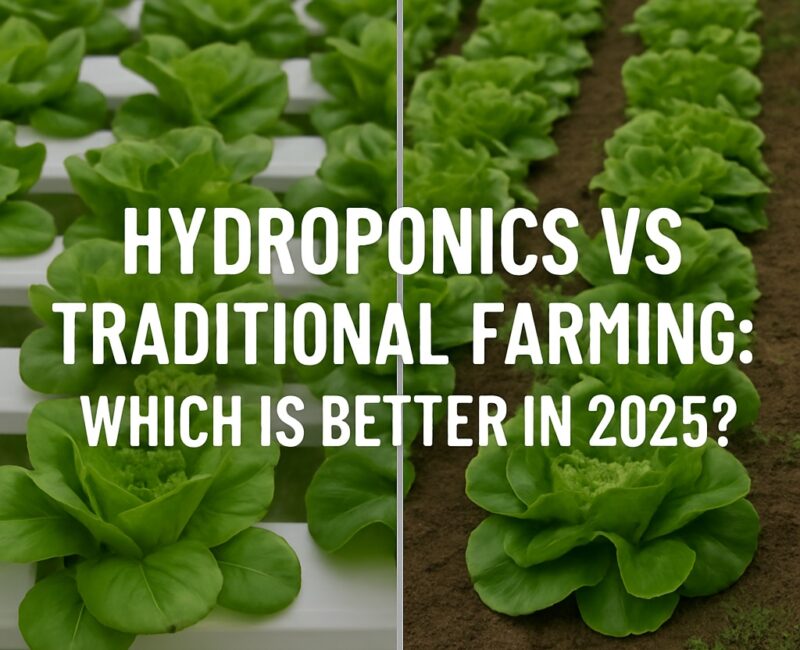As the world faces rising food demands and shrinking farmland, the debate between hydroponics vs traditional farming is heating up in 2025. With climate change, water shortages, and growing urban populations, choosing the right farming method is more critical than ever.
In this blog, we’ll explore both systems — their pros, cons, costs, yields, and what’s trending this year globally.
What Is Hydroponics?
Hydroponics is a soilless farming method where plants grow in nutrient-rich water solutions. This system uses grow lights, controlled environments, and less space.
Key Features:
- Grows plants in water with added nutrients
- Indoor or vertical setups
- Precise control over pH, lighting, and nutrients
Advantages:
- Uses 90% less water than traditional farming
- Grows crops year-round
- Higher yield per square foot
- Great for urban or space-constrained areas
Challenges:
- Higher setup costs
- Electricity dependency (grow lights, pumps)
- Requires technical know-how
Read more – Hydroponic Farming: Is It a Profitable Business?
What Is Traditional Farming?
This is the conventional soil-based method of growing crops on open fields. It depends heavily on seasonal weather patterns and larger land areas.
Key Features:
- Relies on natural sunlight and rain
- Soil-based nutrient delivery
- Often exposed to pests, weeds, and erosion
Advantages:
- Lower setup costs
- No complex systems required
- Rich in biodiversity
- Easier for large-scale cultivation
Challenges:
- Climate-dependent
- High water usage
- More pesticide and herbicide needs
Hydroponics vs Traditional Farming: A 2025 Comparison Table
| Feature | Hydroponics | Traditional Farming |
|---|---|---|
| Water Use | Very low | High |
| Land Use | Minimal (vertical-friendly) | Large fields |
| Yield per Square Foot | High | Medium |
| Pest Control | Easier (indoors) | Difficult (outdoors) |
| Investment Cost | High | Medium |
| Skill Requirement | High (tech knowledge) | Moderate |
| Climate Dependence | Low | High |
| Organic Fertilizer Friendly | Yes | Yes |
Sustainability and Climate Impact
Hydroponics:
- Ideal for climate-smart agriculture
- Works in drought-prone regions
- Reduces soil erosion and land degradation
Traditional Farming:
- More natural ecosystem integration
- Can lead to over-farming and soil loss
2025 Trend: Urban centers like New York, London, and Berlin are pushing hydroponics in rooftops and containers, while rural regions still favor traditional methods for crops like wheat, maize, and pulses.
Cost Breakdown: Which Is More Profitable?
Hydroponics:
- Initial Setup: ₹2-5 lakhs (small unit)
- Operational Cost: Higher due to power + equipment
- ROI: Faster for high-value crops (lettuce, herbs, strawberries)
Traditional Farming:
- Land Lease + Equipment
- Fertilizer + Water Costs
- ROI: Long-term, stable profits (wheat, rice, potatoes)
Pro Tip: Mix both! Many farmers in the U.S. and Europe use hydroponics for niche markets and traditional farming for bulk grains.
Which One Is Better for You in 2025?
Choose Hydroponics if:
- You live in urban areas
- Have limited land or water
- Want faster crop cycles
Choose Traditional if:
- You have access to land and resources
- Prefer tried-and-tested methods
- Focus on large-scale farming
Global Adoption in 2025
- USA & Canada: Vertical farms are scaling fast
- Germany & UK: Heavy investment in smart greenhouses
- Australia & NZ: Water-saving hydroponics booming
- India & Southeast Asia: Gradual hydroponic adoption, but traditional still dominant
Final Thoughts
In 2025, there’s no one-size-fits-all. Hydroponics is the future of space-efficient, water-saving farming, while traditional farming remains the backbone of staple food production.
Want to thrive in agriculture? Learn both systems, adapt with tech, and choose what works best for your goals.





